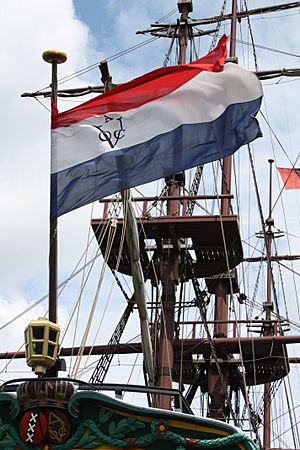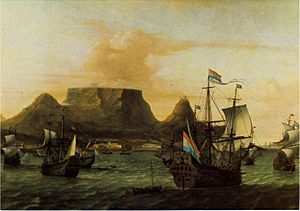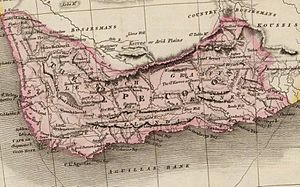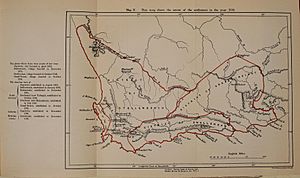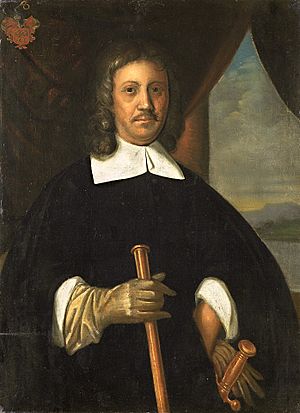Dutch Cape Colony facts for kids
Quick facts for kids
Dutch Cape Colony
Kaapkolonie (Dutch)
|
|||||||||||||
|---|---|---|---|---|---|---|---|---|---|---|---|---|---|
| 1652–1806 | |||||||||||||
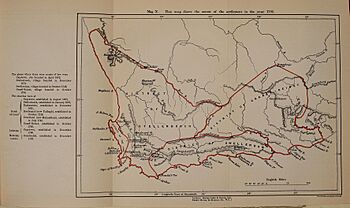
VOC Cape Colony at its largest extent in 1795
|
|||||||||||||
| Status | Colony under Company rule (1652–1795) British occupation (1795–1803) Colony of the Batavian Republic (1803–1806) |
||||||||||||
| Capital | Castle of Good Hope (1st) Kaapstad (2nd) |
||||||||||||
| Official language | Dutch Afrikaans |
||||||||||||
|
Common languages
|
Afrikaans Xiri !Orakobab (Korana language) Khoekhoe isiXhosa |
||||||||||||
| Religion | Dutch Reformed native beliefs |
||||||||||||
| Governor | |||||||||||||
|
• 1652–1662
|
Jan van Riebeeck | ||||||||||||
|
• 1662–1666
|
Zacharias Wagenaer | ||||||||||||
|
• 1771–1785
|
Joachim van Plettenberg | ||||||||||||
|
• 1803–1806
|
Jan Willem Janssens | ||||||||||||
| Historical era | Colonialism | ||||||||||||
| 6 April 1652 | |||||||||||||
|
• Elevated to Governorate
|
1691 | ||||||||||||
| 7 August 1795 | |||||||||||||
| 1 March 1803 | |||||||||||||
| 8 January 1806 | |||||||||||||
| Area | |||||||||||||
|
• Total
|
145,000 km2 (56,000 sq mi) | ||||||||||||
| Population | |||||||||||||
|
• 1797
|
61,947 | ||||||||||||
| Currency | Dutch rijksdaalder | ||||||||||||
|
|||||||||||||
| Today part of | South Africa | ||||||||||||
The Dutch Cape Colony was a Dutch United East India Company (VOC) settlement in Southern Africa. It was located around the Cape of Good Hope, which is how it got its name. This colony and the areas it grew into cover much of what is now South Africa.
From 1652 to 1691, it was a smaller outpost. Then, from 1691 to 1795, it became a larger area called a Governorate. Jan van Riebeeck started the colony in 1652. Its main purpose was to be a place where ships from the Dutch East India Company could stop to get supplies and rest while traveling to and from Asia.
The Cape Colony was under Dutch East India Company rule from 1652 to 1795. Later, from 1803 to 1806, it was ruled by the Batavian Republic. Even though the company mostly cared about making money from Asian trade, the colony quickly grew into a place where many people came to live permanently.
This colony was the only permanent settlement of the Dutch East India Company that wasn't just a trading post. It became a good place for company employees to retire. After working for the company for several years, an employee could rent land in the colony as a Vryburgher (meaning 'free citizen'). They had to grow crops and sell them to the company at a set price.
Because these farms needed a lot of workers, the Vryburghers brought in slaves from places like Madagascar, Mozambique, and Asia. This caused the number of people living in the colony to grow very fast. In 1685, King Louis XIV of France stopped protecting the rights of Huguenots (French Protestants). This led many Huguenot settlers to move to the Cape Colony, where they eventually mixed with the other free citizens.
The company had strict rules, telling farmers what to grow and controlling trade. Some farmers tried to escape these rules by moving further inland. To keep track of these settlers, the company set up new towns like Swellendam in 1745 and Graaff Reinet in 1786. They also said the Gamtoos River was the eastern border, but settlers called Trekboers soon crossed it. To keep out local herding groups, especially the Xhosa people, the company agreed in 1780 to make the Great Fish River the colony's boundary.
In 1795, after a battle near what is now Cape Town, the British took over the colony. But in 1803, under a peace agreement, Britain gave the colony back to the Dutch. Since the Dutch East India Company no longer existed, the colony was now directly ruled by the Dutch government. However, Dutch control didn't last long. In 1806, the British took over the colony again after another battle. In 1814, the Dutch officially gave control of the Cape to Great Britain.
Contents
History of the Cape Colony
Starting the Colony in 1652
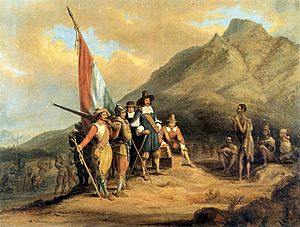
Traders from the Dutch East India Company (VOC) were the first Europeans to set up a colony in South Africa. Their leader, Jan van Riebeeck, started the Cape settlement in 1652. It was meant to be a place where VOC ships could stop for supplies on their long journeys between the Netherlands and Asia. Over time, this support station grew into a community of settlers. These settlers were the ancestors of the Boers and Cape Dutch, who are now known as Afrikaners.
The Khoi People of the Cape
When the first Europeans arrived at the Cape, the southwestern part of Africa was home to the Khoikhoi people. They were herders and hunters. The Khoina, as they called themselves, were upset because the European settlers were taking over their traditional grazing lands near Table Mountain. This led to the first of several conflicts between the Khoi and the Dutch. After one war, the Khoi gave up their land to the settlers in 1660. Later, in 1672, a high-ranking Dutch official formally bought the Cape territory, even though it had already been given up. He did this to try and prevent future arguments.
The settlers' ability to grow food in one place changed the way of life for the local Khoe and Tuu-speaking peoples. They had been nomadic, moving around to find food. By 1672, many local people were living permanently at the Cape.
The first school built by the settlers in South Africa was for slaves rescued from a Portuguese ship in 1658. Later, children of local people and free citizens also attended this school. The Dutch language was taught for business, and many local people and even French settlers started speaking Dutch more than their own languages. Christian ideas were also taught, and many slaves and local residents were baptized.
Sadly, conflicts with the settlers and diseases like smallpox greatly reduced the numbers of the Khoi people in 1713 and 1755. Their society broke down, and many were forced to move beyond the colony's borders. Some ended up working for the colonists, often as shepherds.
Free Citizens (Vryburghers)
The Dutch East India Company liked the idea of having free citizens at the Cape. Many settlers asked to leave the company's service to become "free burghers." In 1657, Jan van Riebeeck agreed and set aside two areas near the Liesbeek River for farming. These areas were called Groeneveld and Dutch Garden. Nine of the best applicants were chosen to farm this land. These free citizens were no longer servants of the company but became subjects of the colony.
Trekboers: Moving Inland
After the first settlers spread out from the main company station, some European farmers, known as Trekboeren (or Trekboers), moved even further inland. They left the richer coastal farmlands for the drier interior. There, they competed with other Khoe-speaking cattle herders for the best grazing lands.
During this time, the Cape society became very diverse. The Afrikaans language grew from this mix. It started as a simple form of Dutch used by different groups, including slaves. Later, it became a written language, first using Arabic letters in Cape Islam. By the time the British took over in 1795, the basic social and political structure of the colony was already well established.
British Takeover of the Cape
In 1795, France took control of the Dutch Republic. Because Britain was at war with France, they decided to occupy the Cape Colony that same year. This helped Britain control the sea routes to India. A British fleet arrived at Simon's Town, and after defeating the Dutch forces, they took control of the area.
The Dutch East India Company officially gave its lands to the Batavian Republic (a new Dutch government set up by France) in 1798. The company then closed down in 1799. When relations between Britain and France improved, Britain handed the Cape Colony back to the Batavian Republic in 1803.
However, the peace didn't last long. In 1806, the British occupied the Cape again after winning the Battle of Blaauwberg. Britain wanted to control the important trade routes to the Far East. In 1814, the Dutch government officially gave the Cape to the British, making it a British colony.
Administrative Divisions
The Dutch Cape Colony was divided into four main areas. In 1797, here's how many people were recorded in each:
| District | Free Christians | Slaves | "Hottentots" | Total (1797) |
|---|---|---|---|---|
| District of the Cape | 6,261 | 11,891 | - | 18,152 |
| District of Stellenbosch and Drakenstein | 7,256 | 10,703 | 5,000 | 22,959 |
| District of Zwellendam | 3,967 | 2,196 | 500 | 6,663 |
| District of Graaff Reynet | 4,262 | 964 | 8,947 | 14,173 |
Population Changes
During this time, many marriages happened between people of different backgrounds. This was partly because there weren't many 'White' or 'Christian' women in the colony. What later became a division between 'White' and 'non-White' people actually started as a difference between Christian and non-Christian groups. Records from 1807 suggest that about seven percent of the Afrikaner family tree came from non-White people.
Here's how the population grew over the years:
| Year | White men | White women | White children | White total | Total population | Notes |
|---|---|---|---|---|---|---|
| 1658 | 360 | Only for Cape Town. | ||||
| 1701 | 418 | 242 | 295 | 1,265 | - | Doesn't include servants. |
| 1723 | 679 | 433 | 544 | 2,245 | - | Doesn't include servants. |
| 1753 | 1,478 | 1,026 | 1,396 | 5,419 | - | Doesn't include servants. |
| 1773 | 2,300 | 1,578 | 2,138 | 8,285 | - | Doesn't include servants. |
| 1795 | 4,259 | 2,870 | 3,963 | 14,929 | Doesn't include servants. | |
| 1796 | - | - | - | - | 61,947 | Total for all groups. |
Leaders of the Cape Colony (1652–1806)
The first leader of the Cape Colony was Jan van Riebeeck. His title was "Commander of the Cape," and he held this position from 1652 to 1662. Later, during the time of Simon van der Stel, the colony grew in importance. Because of this, he was given the higher title of "Governor of the Cape."
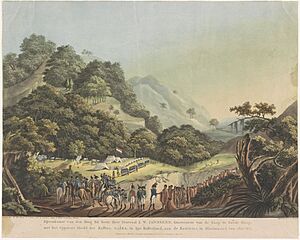
Here are some of the key leaders:
- Jan van Riebeeck: Commander (1652–1662)
- Zacharias Wagenaer: Commander (1662–1666)
- Simon van der Stel: Commander, then Governor (1679–1699)
- Willem Adriaan van der Stel: Governor (1699–1707)
- Ryk Tulbagh: Governor (1751–1771)
- Joachim van Plettenberg: Acting Governor, then Governor (1771–1785)
- Abraham Josias Sluysken: Commissioner-General (1793–1795)
- George Macartney, 1st Earl Macartney: British Governor (1797–1798)
- Jan Willem Janssens: Batavian Republic Governor (1804–1807)
Sources
- The Migrant Farmer in the History of the Cape Colony. P.J. Van Der Merwe, Roger B. Beck. Ohio University Press. 1995. ISBN: 0-8214-1090-3.
- History of the Boers in South Africa; Or, the Wanderings and Wars of the Emigrant Farmers from Their Leaving the Cape Colony to the Acknowledgment of Their Independence by Great Britain. George McCall Theal. Greenwood Press. 1970. ISBN: 0-8371-1661-9.
- Status and Respectability in the Cape Colony, 1750–1870: A Tragedy of Manners. Robert Ross, David Anderson. Cambridge University Press. 1999. ISBN: 0-521-62122-4.




